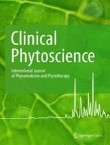Speed 2023
Submission to first editorial decision (median days): 32
Submission to acceptance (median days): 272
Usage 2023
Downloads: 483,277
Altmetric mentions: 33
Methanol extract of Abrus precatorius seeds on reproduction indices, hepatorenal profiles in female albino rats
Abrus precatorious is a member of the leguminous family with characteristic red and black seeds. The roots, leaves and seeds of this plant are used for different medicinal purpose. It principally carries flavonoi...





